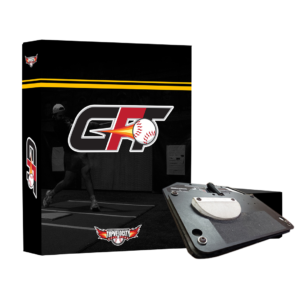 Increase Exit velocity is a baseball phrase that has risen to the forefront of performance research and player development. It's a measure that reveals a lot about a player's striking power and efficiency. This critical quantity measures the speed at which the ball departs off the bat following impact, and it is crucial in determining the ball's trajectory and eventual landing site. A faster exit velocity not only signals a more powerful hit but also increases the likelihood of the ball eluding fielders, resulting in more base hits and home runs.
Increase Exit velocity is a baseball phrase that has risen to the forefront of performance research and player development. It's a measure that reveals a lot about a player's striking power and efficiency. This critical quantity measures the speed at which the ball departs off the bat following impact, and it is crucial in determining the ball's trajectory and eventual landing site. A faster exit velocity not only signals a more powerful hit but also increases the likelihood of the ball eluding fielders, resulting in more base hits and home runs.
This in-depth guide delves into the complexities of exit velocity, investigates its relationship with bat speed, and presents an age-based breakdown to serve as a developmental benchmark. More significantly, we give a specific road map for raising your exit velocity, with a focus on two key aspects: increasing bat speed and establishing consistent square contact. Whether you're a beginner seeking to improve your game or a seasoned pro looking to keep your edge, this article will provide you with vital insights and effective tactics to help you smash the ball harder and farther.
Increase Exit Velocity Analysis
Exit velocity is the rate at which a baseball departs the bat after making contact. It's an important indicator for assessing a player's hitting ability because it directly correlates with the distance the ball goes. The greater the exit velocity, the harder the ball was struck and the further it is expected to fly. Notably, Giancarlo Stanton has the highest recorded exit velocity in Statcast history, at a staggering 122.2 mph.
The Bat Speed and Exit Velocity Relationship
The rate at which a batsman swings their bat is referred to as bat speed. A rapid bat speed is an important factor in creating high exit velocity. You can directly enhance your potential exit velocity by increasing your bat speed. The two have a linear relationship. Exit velocity increases by 1.2 mph for every 1 mph increase in bat speed. This association emphasizes the need for bat speed training.
Exit Velocity by Age
Exit velocity is a long-term process that varies with age. Younger players often have lower exit velocities, but as they learn and enhance their talents, these velocities increase. The median maximum exit velocity for a 9-year-old, for example, is at 47.80 mph, but it rises to 92.80 mph for an 18-year-old and 105.40 mph for a 24-year-old. Exit velocity tracking by age provides a useful baseline for coaches and players alike, assisting in contextualizing training goals.
How to Increase Exit Velocity
To increase your exit velocity, you must concentrate on two key factors: increasing your bat speed and making continuous square contact with the ball.
Bat Speed Enhancement
 Here are some tried-and-true methods for increasing your bat speed:
Here are some tried-and-true methods for increasing your bat speed:
- Strength Training: Include strength training in your routine. As a powerful swing requires the complete body, focus on both upper and lower body movements. The faster you can swing the bat, the stronger your muscles are.
- Bat Drills: Experiment with various bat drills. These can aid in the development of quick hands, improved timing, and, eventually, increased bat speed.
- Optimal Bat Weight: Choose a bat weight that is appropriate for your strength and swing style. A bat that is too hefty can slow down your stroke.
Square Contact That Is Consistent
Making square contact with the ball involves hitting it with the "sweet spot" of the bat. The following tactics can assist you in accomplishing this:
- Eye Training: Practice tracking the ball from the pitcher's hand to your bat on a regular basis. This exercise can help you improve your hand-eye coordination, which is necessary for creating square contact.
- Swing Plane: Adjust your swing plane to match the pitch plane. This alignment improves the likelihood of making square contact.
- Batting Tees: Batting tees are useful for practicing your swing and making consistent contact. Begin by positioning the tee at various heights and places to simulate various pitch types.
You may gradually raise your exit velocity and become a more powerful hitter by focusing on these two factors and incorporating these tactics into your training.
Exit Velocity by Progression
This bar chart illustrates the typical progression of exit velocity from the age of 9 years to 24 years, highlighting the potential for improvement as a player grows and refines their skills.
In conclusion, enhancing your exit velocity is a process that requires dedication, practice, and the right techniques. By prioritizing bat speed and consistent square contact, you can expect a steady increase in your exit velocity over time, resulting in harder hits and further drives.
Exit Velocity Development Flow Chart
Frequently Asked Questions
- What is the definition of Exit Velocity in Baseball?
Exit velocity is the rate at which a baseball departs the bat after being hit. It's an important metric for determining the strength and efficiency of a batter's swing. - What is the definition of Exit Velocity?
Advanced radar technology and technologies such as HitTrax units or Statcast systems are used to determine exit velocity. These instruments measure the speed of the ball as soon as it leaves the bat. - What Is the Importance of Exit Velocity?
A harder hit ball with a higher exit velocity usually leads in more base hits or home runs. It also indicates a player's hitting power and bat speed. - What Can I Do to Improve My Exit Velocity?
Increasing your bat speed and making consistent square contact with the ball are the two basic strategies to raise your exit velocity. This can be accomplished through targeted training that incorporates both strength and skill-based drills. - Is There a Relationship Between Bat Speed and Exit Velocity?
Yes, bat speed and exit velocity have a linear connection. Exit velocity normally increases by +1.2 mph for every one mph increase in bat speed. - Is Average Exit Velocity an Accurate Measure of a Player's Ability?
While average exit velocity can provide some useful information, it includes balls in play, even mishits, which might be misleading. Top 8th EV, which measures the average of a player's hardest 12.5% of hit balls, is a more dependable metric. - Does Exit Velocity Increase as You Get Older?
In most cases, yes. As players develop their skills, their bat speed and ability to make square contact improve, resulting in an increase in exit velocity. Individual results, however, can differ depending on a number of factors, including training program and physical growth.
Increase Exit Velocity with the GFT Hitting Program
 Now that you've gained an understanding of the critical role exit velocity plays in your hitting performance, it's time to put this knowledge into action. The GFT Hitting Program is designed to help players of all ages and skill levels unlock their full potential and achieve their baseball aspirations.
Now that you've gained an understanding of the critical role exit velocity plays in your hitting performance, it's time to put this knowledge into action. The GFT Hitting Program is designed to help players of all ages and skill levels unlock their full potential and achieve their baseball aspirations.
Our program provides a comprehensive, step-by-step approach to increasing your exit velocity. We focus on improving your bat speed, ensuring consistent square contact, and optimizing your swing mechanics. But we don't stop there; we also foster a deep understanding of hitting principles, ensuring you know the 'why' behind every technique.
The GFT Hitting Program incorporates advanced analytics and personalized coaching to deliver a training regimen tailored to your unique needs. Our experienced coaches, armed with a wealth of baseball knowledge and a passion for player development, provide consistent feedback, ensuring your progress is on track.
Don't wait to take your game to the next level. Join the GFT Hitting Program today and begin your journey to becoming a power hitter. Remember, every swing you take is an opportunity to improve. Make each one count!


